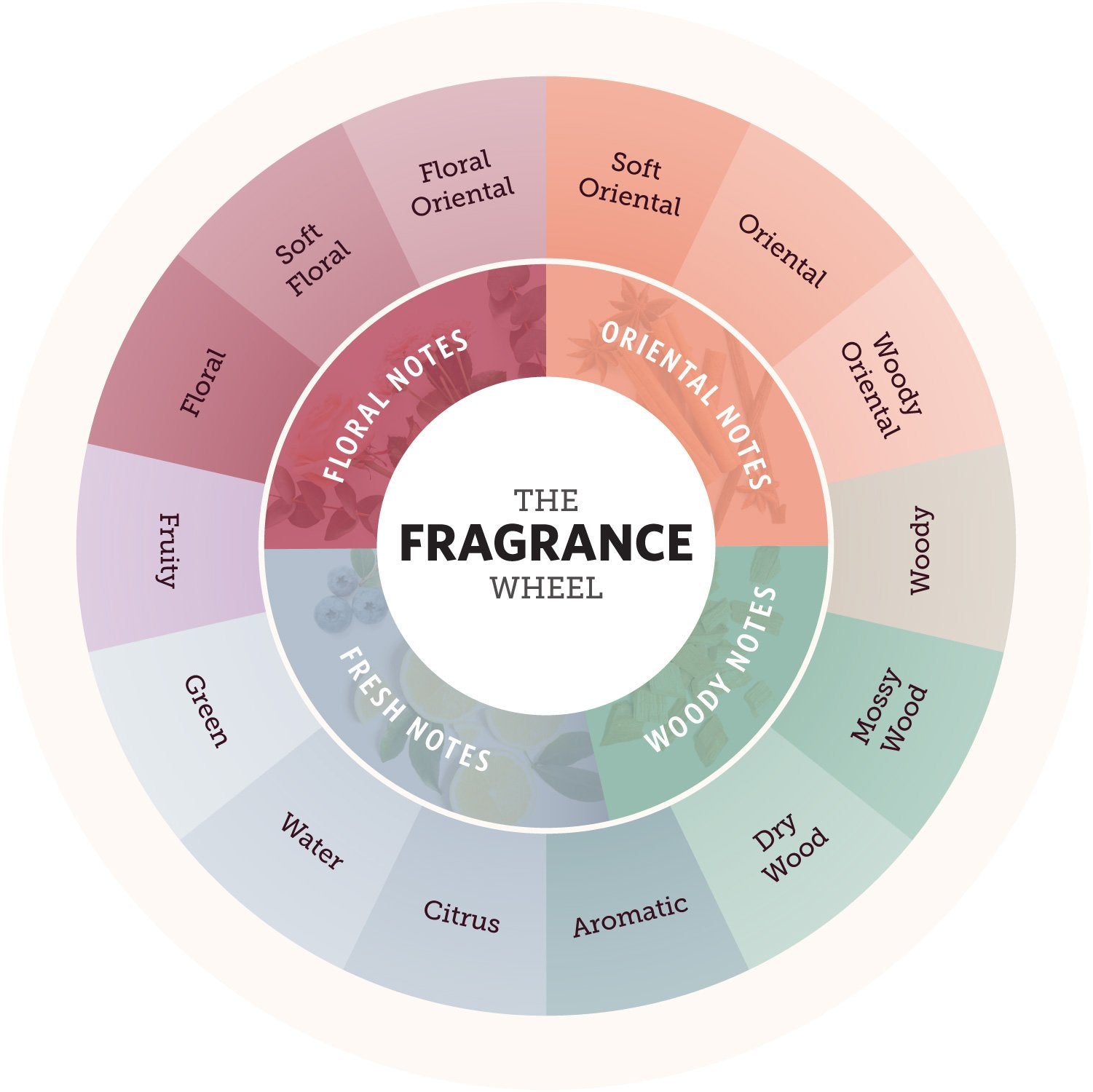Do you remember back in school when you would be shown a colour wheel for art? Colours sat next to eachother based on how they blended into eachother and the colours opposite would clash with eachother? Well the fragrance wheel works in a very similar way but instead of colours it is made up of four main fragrance categories which then divide up even further. The fragrance wheel is very useful to help you determine which scents you are typically drawn to with your fragrance. If you're purchasing a fragrance without smelling it first then this is a great way to work out if it will be the right match for you.

History of the fragrance wheel
An Australian perfume-maker Paul Jellinek is widely credited with inventing the fragrance wheel in 1949. First published in his book The Practice of Modern Perfumery his diagram detailed how various scents related to one another, in terms of their olfactory personality (otherwise known as their smell). Since this discovery many perfumers have developed Jallinek's concept further. These perfumers include Michael Edwards who in 1992 adapted the wheel to the version we use today. As well as developing the wheel, Edwards is also author of ‘Fragrances of the World’, making him the leading expert on fragrance classification.
About the wheel
Made up of four main categories, floral, woody, oriental and fresh, are sub-groups. These sub-groups describe each scent in more detail such as 'fresh citrus' and 'soft floral'. Where a fragrance is placed on the wheel is important. Depending on the notes that are added a floral scent could become a 'soft floral' or 'floral oriental'. Typically people prefer fragrances from one or two families. The sub-categories are:
- Aromatic. Lavender and other aromatic herbs
- Citrus. Lime, lemon and bergamot
- Fruity. This means non-citrus fruits and berries
- Green. ‘Green’ notes like galbanum
- Water. Aquatic and marine notes – reminiscent of the sea
- Woods main. Aromatic woods and vetiver
- Mossy woods – amber and oak moss
- Dry woods. leather and dry woods
- Floral. Freshly cut flowers
- Soft floral. Powdery notes and aldehydes
- Floral oriental. Sweeter spices and orange blossom
- Soft oriental. Amber and incense
- Oriental. Oriental resins
- Woody oriental. Patchouli and sandalwood
Floral

- Fruity: Sweet, edible and tropical like peach, pear and apple.
- Floral: Smells like fresh-cut flowers — imagine rose and lily.
- Soft floral: Soft, powdery and sweet with a hint of creamy.
- Floral oriental: Florals with subtle spice notes.
Our floral fragrances are:
- English Cherry Blossom
- Blueberry Musk
- Amber Rose
- Atropa Belladonna
- Scarlet Lily
Fresh

The fresh scent family can be described as clean bright scents. Aquatic, herby, citrusy and oceanic scents all fall into this category. More often used in men’s fragrances than women’s fragrances, fresh scents are paired with spicy notes to create a more robust fragrance. Aromatic, tart notes can also be found mixed with zesty or fruity scents. The sub fimilies are made up of:
- Aromatic: Clean and fresh herbs mixed with lavender or woody scents.
- Citrus: Zesty or tangy notes like mandarins or bergamot.
- Water: Aquatic scents that smell of sea spray or rain mixed with or oceanic notes.
- Green: Smells of freshly mowed lawns and crushed green leaves.
Our fresh fragrances are:
- Sicilian Limes
- Blackberry Woods
- Watermelons
Woods

Woody perfumes are usually warming and luxurious. Deeper notes such as patchouli or sandal wood are often mixed with dry notes like cedar. Citrus notes are also a common combination such as the refreshing citrus burst of oranges combined with its notes of musk, woods and smoky leather in our Blood Oranges fragrance. Notes in this family can be described as coniferous or woody and bitter. Notes typically are Patchouli, Veviter and Sandalwood and the sub families include:
- Woods: Aromatic scents like cedarwood, sandalwood and vetiver.
- Mossy woods: Sweet, smooth and earthy scents like oakmoss and amber.
- Dry woods: Smouldering and smoky mixed with leather aromas.
Our wood fragrances include:
- Oud Alif
- Dandelion Fig
- Kings Wood
- Blacks Club Leather
- Blood Oranges
Oriental

Made up of rich, exotic scents the oriental family makes you think of herbs and spices or dry, powdery, resin notes. These fragrances are often then softened with sweeter notes such as chocolate or amber. This fragrance family is typically described as seductive and exotic. The sub-families of oriental fragrances are:
- Soft oriental: Soft, floral notes mix with incense and warm spices.
- Oriental: Sweet, warm notes like cinnamon, vanilla and musk.
- Woody oriental: Earthy notes like patchouli and sandalwood mixed with spicy and sweet notes.
Our oriental fragrances include:
- Salt Caramel
- Black Tulip
- Parfum Nashwa
- Amber Oud Ahad
How to combine fragrances
The same way you would use a colour wheel to work out which colours go together you can use the fragrance wheel to work out which scents to layer. Take a look at the sub families that are next to eachother, fragrances from these families will almost always blend well together.
You can also pick a sub-family to start with and see which note appears across from it on the fragrance wheel. This means that those notes are complementary to one another. For example, soft oriental will complement citrus, and oriental will complement water.
Finally, you can select three fragrance sub-families that create a triangle on the fragrance wheel. You’ll find that these will complement each other nicely. For example, if you know you like floral oriental notes, look for a scent that contains mossy and water notes as well.
Like this article? Sign up to our newsletter to get more delivered straight to your inbox
_____________
References:
https://copycatfragrances.co.uk/blogs/posts/understanding-the-fragrance-wheel
https://www.fragrancex.com/blog/fragrance-wheel/
https://www.allbeauty.com/articles/the-fragrance-wheel-explained-and-how-to-use-it
 Welcome to...
Welcome to... Austria
Austria
 Belgium
Belgium



Share:
'Cheap' vs 'Expensive' Fragrances, Is There A Big Difference?
Florals - Not Just for Girls